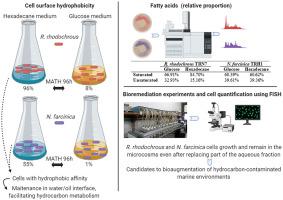Environmental Pollution ( IF 7.6 ) Pub Date : 2020-09-18 , DOI: 10.1016/j.envpol.2020.115579 Edmo Montes Rodrigues , Dionéia Evangelista Cesar , Renatta Santos de Oliveira , Tatiane de Paula Siqueira , Marcos Rogério Tótola

|
Limitations
of bioaugmentation strategies are an obstacle for damage mitigation caused by oil spills in marine environments. Cells added to the contaminated sites are quickly lost by low adherence to the contaminants, rendering ineffective. This study used two hydrocarbonoclastic species - Rhodococcus rhodochrous TRN7 and Nocardia farcinica TRH1 cells - growing in mineral medium containing hexadecane to evaluate cell distribution in a crude-oil contaminated marine water. Cell affinity to hydrophobic compounds was quantified using Microbial Adhesion to Hydrocarbons test and analysis of fatty acids profile was performed using the Microbial Identification System. Bioremediation simulations were set up and cell populations of both strains were quantified by Fluorescent in situ Hybridization. R. rhodochrous and N. farcinica reached up to 97% and 60% of adhesion to hexadecane, respectively. The carbon source had more influence on the fatty acid profiles of both strains than the microbial species. The presence of 45.24% of 13:0 anteiso on total fatty acids in R. rhodochrous and 12.35% of saturated fatty acids with less than 13 carbons atoms in N. farcinica, as well as the occurrence of fatty alcohols only in presence of hexadecane in both species, are indicators that fatty acid changes are involved in the adaptation of the cells to remain at the water/oil interface. Cell quantification after bioremediation simulations revealed an increase in the density of both species, suggesting that the bioremediation strategies resulted on the increase of hydrocarbonoclastic species and up to 27.9% of all prokaryotic microbial populations in the microcosms were composed of R. rhodochrous or N. farcinica. These findings show the potential of application of these two bacterial strains in bioaugmentation of hydrocarbon-contaminated marine ecosystems.R. rhodochrous TRN7 and N. farcinica TRH1 hydrocarbonoclastic strains modify the fatty acid profile and increases density, optimizing hydrocarbons biodegradation.
中文翻译:

在十六烷上生长的碳氢碎裂细菌物种:对海洋生态系统生物强化的影响
局限性
生物强化策略的存在是减轻海洋环境中溢油造成的损害的障碍。由于对污染物的低粘附性,添加到受污染部位的细胞会迅速丢失,从而使失效。这项研究使用了两种碳氢碎屑物种,即Rhodococcus rhodochrous TRN7和Nocardia farcinica TRH1细胞,它们生长在含有十六烷的矿物培养基中,以评估在原油污染的海水中细胞的分布。细胞对疏水性化合物的亲和力通过微生物对碳氢化合物的粘附测试进行定量,脂肪酸谱的分析则通过微生物鉴定系统进行。建立了生物修复模拟,并通过荧光原位定量两种菌株的细胞群体杂交。玫瑰色红球菌和N. farcinica分别达到高达97%的和粘附的60%十六烷。碳源比微生物菌种对两种菌株的脂肪酸谱影响更大。的的13%45.24的存在:0反异在总脂肪酸玫瑰色红球菌并在小于13个碳原子的饱和脂肪酸的12.35%N. farcinica以及两个物种中仅在十六烷存在下才出现脂肪醇,这表明脂肪酸的改变与细胞适应性有关,从而保留在水/油界面。生物修复模拟后细胞定量揭示在这两个物种的密度的增加,这表明生物修复策略导致上hydrocarbonoclastic物种的增加和至多在缩影所有的原核微生物种群的27.9%组成为:玫瑰色红球菌或N. farcinica。这些发现表明这两种细菌菌株在碳氢化合物污染的海洋生态系统的生物增强中的应用潜力。红球菌TRN7和N. farcinica TRH1碳氢碎裂菌株可改变脂肪酸谱并增加密度,从而优化碳氢化合物的生物降解。











































 京公网安备 11010802027423号
京公网安备 11010802027423号